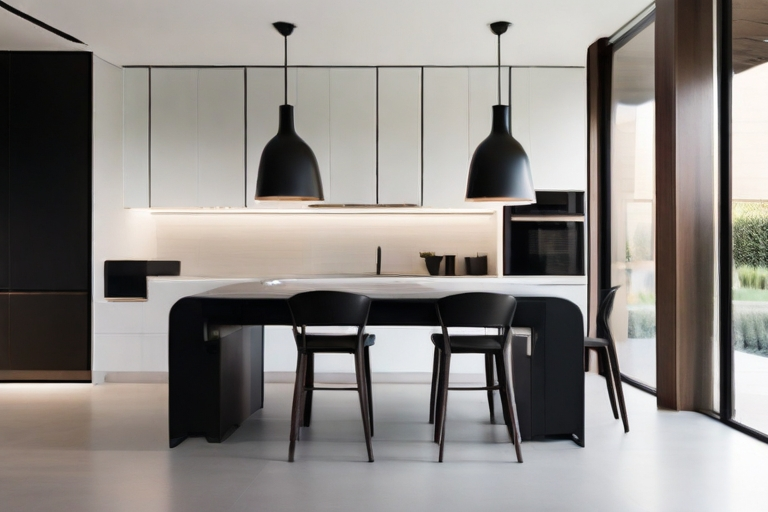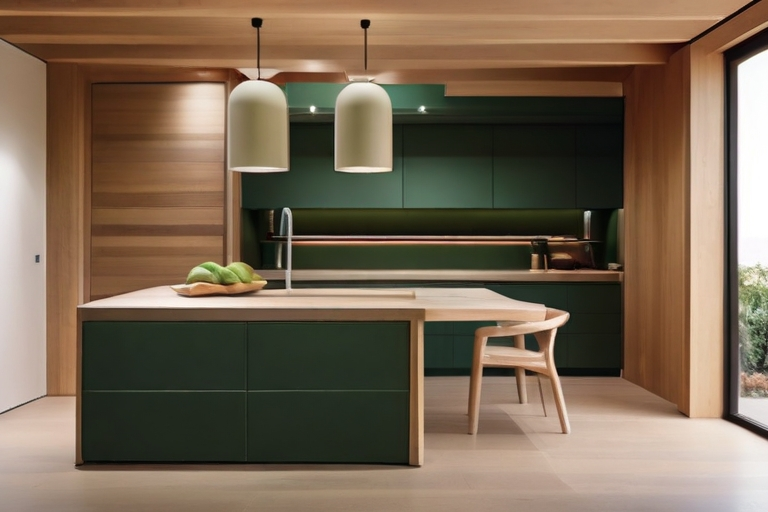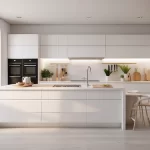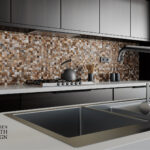The Art of Minimalist Kitchen Design: Simplifying Your Space
n recent years, minimalist kitchen design has surged in popularity, emerging as a preferred aesthetic for homeowners seeking a blend of contemporary style and functional simplicity. Minimalism in the kitchen is more than just a visual statement; it’s a lifestyle choice that embraces the adage “less is more,” promoting a clutter-free and intentional living space.
The allure of minimalist design lies in its ability to create tranquility and order within the home’s culinary hub. By stripping away the unnecessary and focusing on the essentials, minimalist kitchens offer a sense of calm, making the space feel larger and more open. The simplicity of this design philosophy can also lead to a more serene and focused environment, where each element serves a purpose and excess is eliminated.
A minimalist kitchen goes beyond just aesthetics; it can positively impact daily life. Streamlined workflows, easy maintenance, and a clutter-free environment contribute to a more efficient cooking experience. Furthermore, this minimalist approach can influence overall well-being, as a decluttered space can reduce stress and promote mental clarity.
As we delve into the art of minimalist kitchen design, we’ll explore how you can simplify your space and incorporate minimalist principles into your home. Whether you’re undertaking a full kitchen renovation or seeking ways to reduce counter chaos, this guide will provide you with the insights needed to transform your kitchen into a bastion of minimalist beauty.
Key Elements of Minimalist Kitchen Design
A minimalist kitchen is defined not just by what is included, but also by what is purposefully excluded. Here are the key design elements that make up the minimalistic approach, ensuring that your kitchen is both visually calming and functionally rich.
- Clean Lines and Uncluttered Surfaces: The hallmark of minimalist design is clean, straight lines that create a sleek and modern look. Kitchens with uncluttered surfaces enhance this effect, contributing to an atmosphere of order and space. Intentionally keeping countertops free of unnecessary items can instantly give the kitchen a more organized feel.
- Monochromatic Color Schemes and Subtle Textures: Minimalist kitchens often feature a monochromatic color palette, relying on a single hue or a combination of similar shades to create a harmonious visual flow. Subtle textures can add depth and interest to the space without overwhelming it, ensuring that the kitchen feels warm and inviting despite its simple color scheme.
- Functionality and Efficiency in Layout and Storage: The minimalist kitchen isn’t just about looking good; it must be highly functional too. This includes an efficient layout that optimizes movement and tasks, smart storage solutions that keep everything in its place, and appliances that offer maximum utility without unnecessary complexity.
Each of these elements contributes to the minimalist kitchen’s core principles: simplicity and functionality. By incorporating these key features, you can create a space that is both aesthetically pleasing and highly practical.
Decluttering Your Kitchen Space

The process of creating a minimalist kitchen starts with decluttering—a critical step that involves paring down your kitchen items to the essentials. This doesn’t just help in achieving a minimalist look; it also makes your kitchen more functional by ensuring that everything within reach is something you use and value.
- Tips for Reducing Kitchen Items to Essentials: Start by emptying all cabinets and drawers, and then sort through each item. Ask yourself if you’ve used it in the past year and if it serves a specific purpose. Keep only the items that are essential for your daily kitchen tasks. Consider donating or selling the rest.
- How to Maintain a Clutter-Free Kitchen Environment: To keep clutter at bay, adopt the habit of immediate clean-up after every meal or cooking session. Implement a ‘one in, one out’ policy for kitchen gadgets and utensils; if you bring in something new, let go of another item. Additionally, use drawer organizers and cabinet dividers to keep everything in its designated place, making it easier to maintain order.
Decluttering is not a one-time task but an ongoing process that requires commitment. By consistently keeping tabs on what enters your kitchen and ensuring that only what is necessary remains, you’re not just organizing your space—you’re also fostering the minimalist mindset that is central to this design philosophy.
Choosing the Right Appliances and Fixtures
In a minimalist kitchen, the appliances and fixtures you choose play a pivotal role. Not only do they need to blend seamlessly with the minimalist aesthetic, but they must also be functional and efficient to avoid the need for additional gadgets that can clutter the space.
- Selecting Sleek, High-Functioning Appliances That Blend with the Design: Look for appliances with clean lines and simple, intuitive interfaces. Built-in appliances that can be integrated into cabinetry offer a seamless look, and choosing a consistent finish, like stainless steel or matte black, can tie the room together.
- Importance of Quality over Quantity in a Minimalist Setup: With a minimalist approach, each item needs to earn its place in the kitchen. This means selecting high-quality appliances that are durable and perform multiple functions can reduce the need for single-use gadgets. A high-powered blender, for instance, can take the place of various smaller appliances.
When choosing fixtures like faucets and sinks, simplicity and functionality should drive your decisions. Opt for designs that are both elegant and easy to clean, with features that enhance their usability, such as pull-down faucet heads or deep, single-basin sinks.
The right appliances and fixtures can make a significant difference in maintaining a minimalist kitchen. By choosing wisely, you can ensure that your kitchen remains uncluttered and that the tools at your disposal enhance your cooking experience without contributing to visual noise.
Storage Solutions for a Minimalist Kitchen
An integral part of a minimalist kitchen is how storage is handled. The goal is to have a place for everything and everything in its place. This not only helps to maintain an uncluttered look but also ensures that the kitchen remains practical and user-friendly.
- Innovative Cabinet Designs and Hidden Storage Options: Modern cabinetry is the minimalist’s ally, offering sleek designs with push-to-open mechanisms that negate the need for handles, contributing to a clean facade. Cabinets can also be fitted with custom inserts and pull-out systems that maximize space and provide easy access to stored items. Furthermore, hidden storage options such as pop-up shelves or appliance garages keep countertops clear and appliances out of sight when not in use.
- Using Vertical Space and Open Shelving Strategically: Don’t overlook the potential of vertical space. Tall cabinetry can increase storage capacity, while hanging items such as pots and utensils can save drawer space. Open shelving should be used sparingly in a minimalist kitchen, displaying only the most aesthetically pleasing and frequently used items to avoid visual clutter.
Each storage solution should be chosen with the minimalist philosophy in mind: Reduce clutter, maintain simplicity, and ensure ease of use. By investing in the right storage systems, you can preserve the sleek look of your minimalist kitchen while still enjoying the functionality of a fully equipped cooking space.
Maintaining the Minimalist Aesthetic

Once you have successfully streamlined your kitchen into a model of minimalist design, the challenge becomes maintaining this aesthetic over time. A minimalist kitchen not only looks clean and simple but also promotes a lifestyle that reduces excess and emphasizes intentionality in both design and practice.
- Daily Habits for Keeping Your Minimalist Kitchen Pristine: The key to maintaining a minimalist kitchen is to develop and stick to daily habits that prevent clutter and mess. This includes promptly washing dishes after use, immediately putting ingredients away after cooking, and conducting a nightly wipe-down of surfaces to keep the space looking neat and inviting.
- Seasonal Decluttering and Thoughtful Acquisitions: As seasons change and new products enter the market, it can be tempting to add more items to your kitchen. To maintain the minimalist aesthetic, engage in regular decluttering sessions where you reassess your kitchen’s inventory. When considering new purchases, be mindful and deliberate—ensure that each new item serves a clear and practical purpose or replaces something that no longer does.
Staying true to minimalist principles requires ongoing attention and discipline, but the rewards are a kitchen that is always ready for use, free from unnecessary distractions, and remarkably pleasant to be in. The minimalist kitchen isn’t just a space—it’s a testament to the calm and order that can be achieved through simplicity and careful curation.
The journey to a minimalist kitchen is both a design challenge and a lifestyle adjustment, but with consistent effort, the principles of minimalism will become second nature. This approach will not only transform your kitchen but can also inspire a broader minimalist perspective throughout your home and life.
Conclusion
The minimalist kitchen is more than just a trend; it’s a reflection of a lifestyle choice that values simplicity, efficiency, and tranquility. Through this journey, we’ve uncovered the principles that underpin the art of minimalist kitchen design, from decluttering and choosing the right appliances to implementing smart storage solutions and maintaining the minimalist ethos.
Adopting a minimalist approach in your kitchen can bring a sense of calm to the often hectic pace of daily life. It aligns your space with your intentions, creating an environment that facilitates focus and mindfulness. With every item and design choice carefully considered, the minimalist kitchen becomes a sanctuary of simplicity, where every moment spent is one of purpose and clarity.
Whether you are embarking on a new kitchen project or seeking to redefine your existing space, embracing minimalist design can have a transformative impact on both your home and your lifestyle. It’s an invitation to step away from the excess and appreciate the beauty and serenity that come with having just enough.
For those inspired to bring the elegance and simplicity of minimalist design into their kitchens, Vega Kitchen & Bath Design is here to help. We offer expert guidance and a personalized approach to ensure that your minimalist vision becomes a reality. Our commitment is to create spaces that embody the principles of minimalism while catering to the unique needs of each client.
Join us at Vega Kitchen & Bath Design in crafting a kitchen space that is not only aesthetically pleasing but also a testament to the minimalist way of life. Contact us today, and let’s take the first step toward simplifying your space—and your life.






